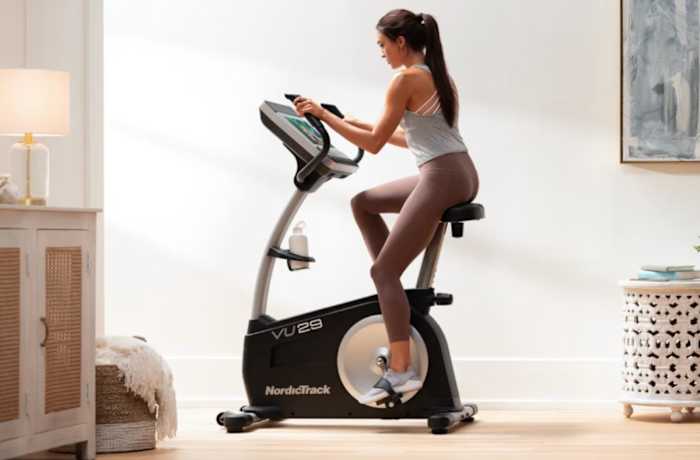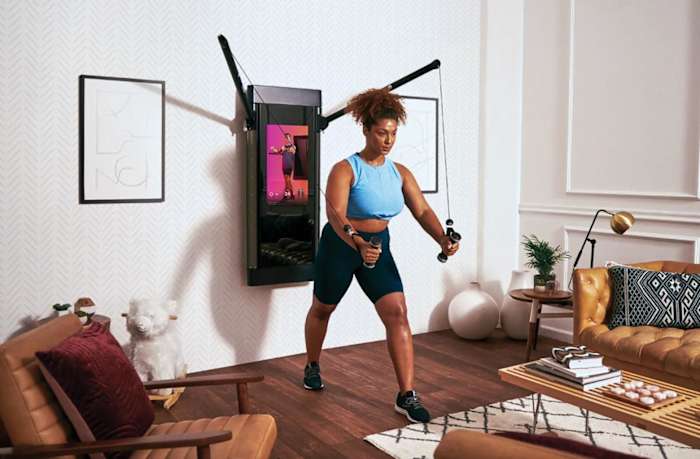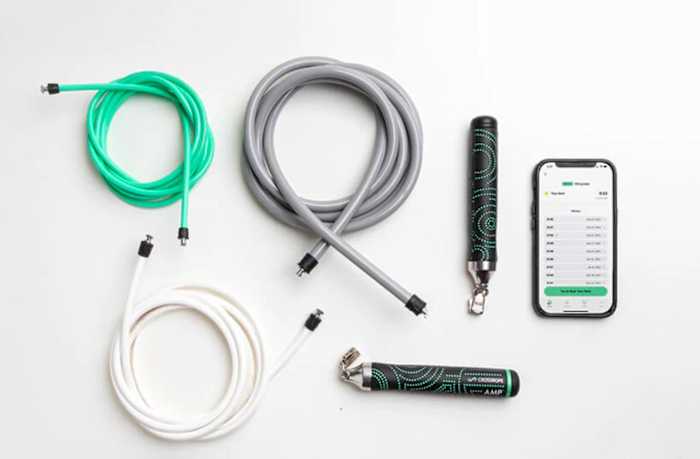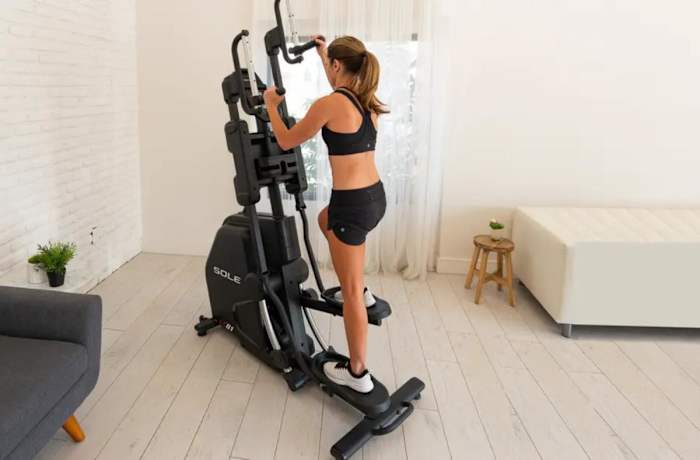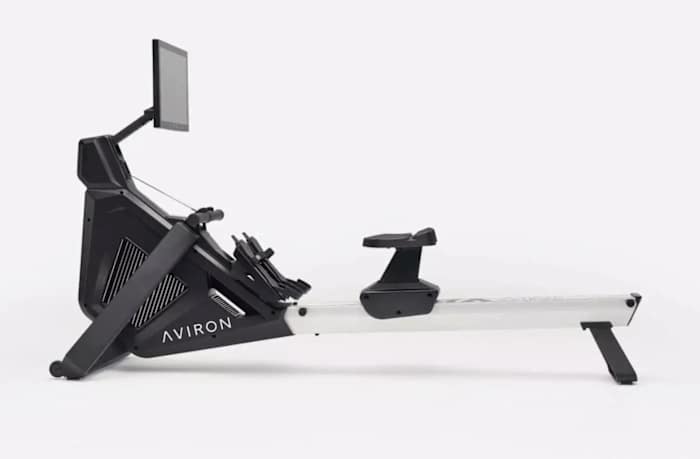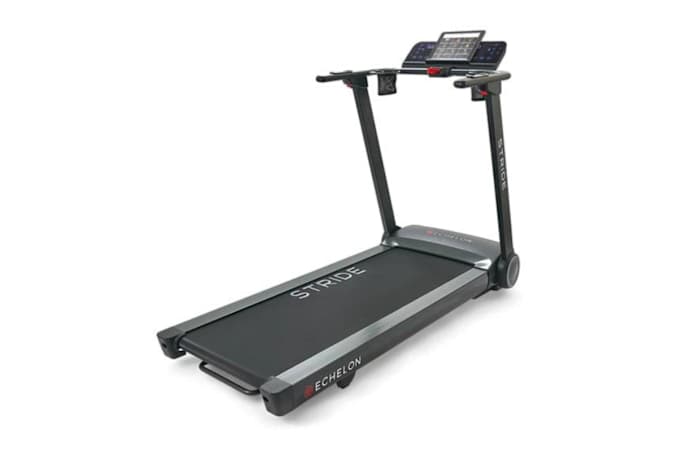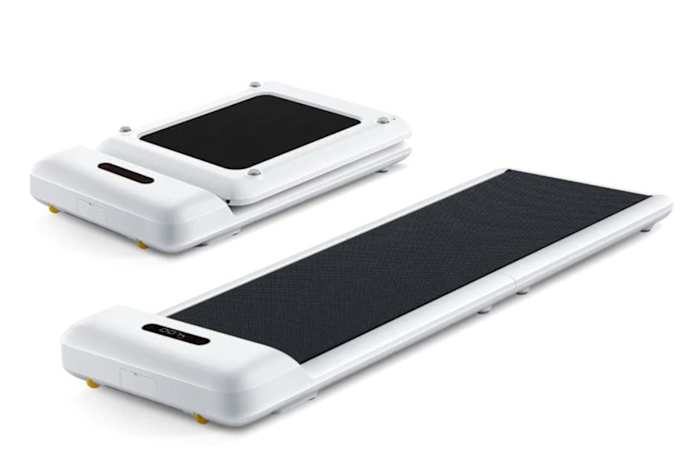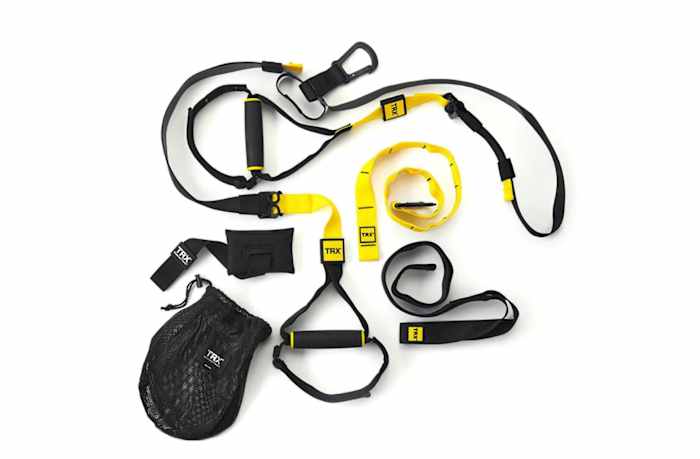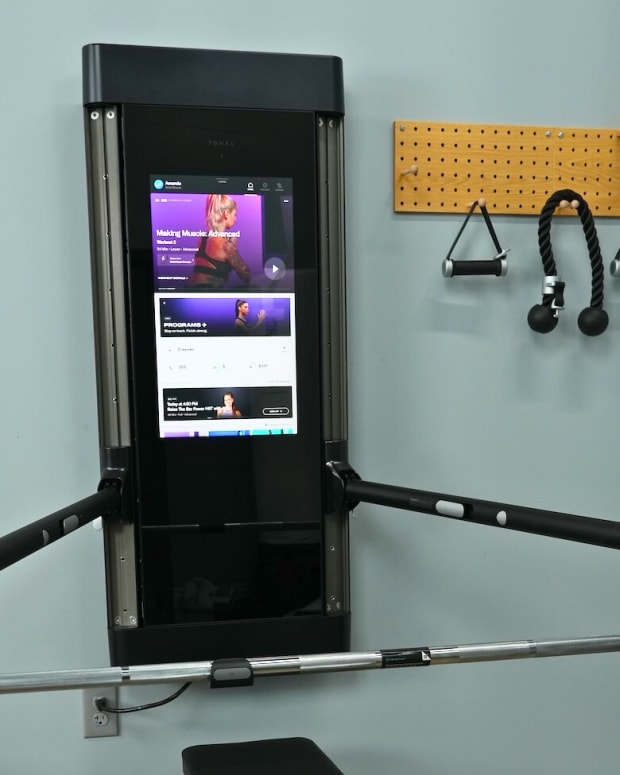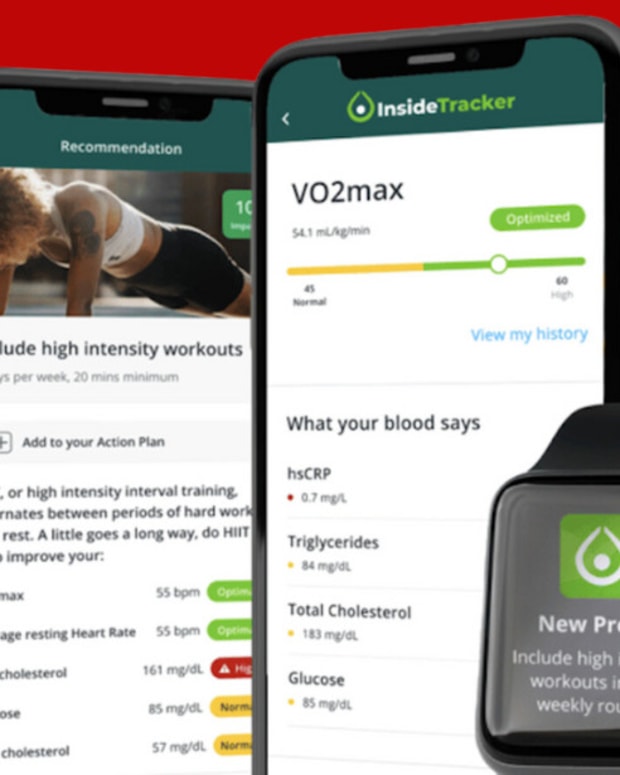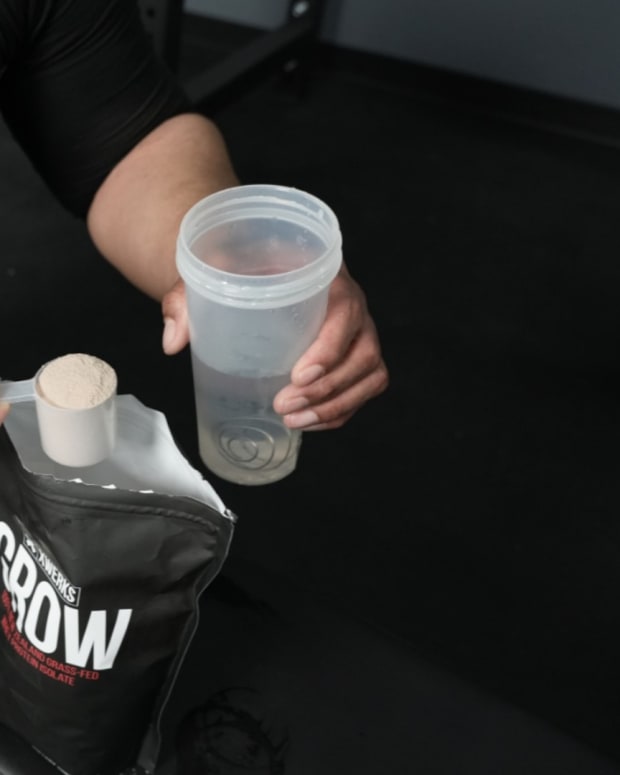The products featured in this article have been independently reviewed. When you buy something through the retail links on this page, we may earn commission at no cost to you, the reader. Sports Illustrated editorial staff are not involved in the creation of this content. Learn more here.
At-home exercise is here to stay: Nearly 75 percent of exercisers work out in their own home or apartment gym, one 2023 survey found. As a result, the global home fitness equipment market is expected to grow from $15.13 billion in 2022 to $16.55 billion in 2023, a growth rate of 9.3 percent. That’s huge.
But limited space shouldn’t limit your fitness potential. No matter what your square footage is, working out at home doesn’t have to mean investing in space-consuming equipment like a bulky bike or massive elliptical—and getting a solid cardio workout doesn’t mean you have to go outside. The Physical Activity Guidelines for Americans recommends that you get 150 minutes of moderate aerobic activity, 75 minutes of vigorous aerobic activity or some combination of the two per week, and you can do that with equipment as simple as a jump rope, or as low-profile as a folding, under-desk treadmill.
To help you break a sweat at home, no matter how little room you have, these are our picks for the best compact cardio equipment for small spaces. This comprehensive guide will break down what types of machines are available, how to use them, why they’re beneficial and what features to consider when you’re trying to find the best one for you and your home.
Our Picks for the Best Cardio Equipment for Small Spaces:
- Best Exercise Bike for Small Spaces: NordicTrack Commercial VU 29
- Best Smart Gym for Small Spaces: Tonal
- Best Smart Jump Rope for Small Spaces: Crossrope AMP
- Best Climber for Small Spaces: Sole Intense Climber
- Best Elliptical for Small Spaces: ProForm HIIT H14
- Best Rower for Small Spaces: Aviron Strong Series
- Best Treadmill for Small Spaces: Echelon Stride
- Best Under-Desk Treadmill for Small Spaces: WalkingPad C2
- Best Suspension Trainer for Small Spaces: TRX Pro 4
Best Exercise Bike for Small Spaces: NordicTrack Commercial VU 29
Key specs and features:
- Price: $1,299
- iFIT subscription cost: $39/month after 30-day trial
- Resistance levels: 24
- Screen: 14-inch touchscreen
- Measurements: 55.29 inches high, 24.86 inches wide, 41.49 inches long
Thanks to ginormous, immersive screens, stationary bikes can take up a surprising amount of space in your home. This streamlined indoor cycling option from NordicTrack keeps things simple, with a 14-inch touchscreen that allows you to access thousands of on-demand workout options, from studio classes to scenic rides all over the world to off-the-bike sessions that complement your riding (you’ll need an iFIT membership to access all those). The 19-pound flywheel is powered by Silent Magnetic Resistance, which guarantees you won’t disturb your housemates, and Bluetooth capabilities that let you sync wireless headphones to the machine so you can blast your music as loud as you want.
Check out our NordicTrack Commercial VU 29 review for more information on this stationary bike.
Pros:
- Trainers automatically adjust the resistance as you work out
- Oversized cushion seat for comfort
- Allows for horizontal and vertical seat adjustments
Cons:
- No built-in workout programs
- Not foldable, and no transport wheels
Best Smart Gym for Small Spaces: Tonal
Key specs and features:
- Price: $3,995
- Tonal subscription cost: $59.95/month
- Max weight: 200 pounds (100 pounds per arm)
- Screen: 24-inch touchscreen
- Measurements: 21.50 inches wide, 50.9 inches high, 5.25 inches deep
Tonal replaces the clutter created by racks of free weights with a wall-mounted smart gym that can generate up to 100 pounds of resistance via each extendable arm. And instead of requiring you to manually re-rack weight plates, the electromagnetic motor adjusts the load in less than a second—decreasing the weight if you’re struggling, adding it if you're banging out reps too easily and adding heavier weights to the eccentric portion of an exercise in order to make it more challenging. The 24-inch touchscreen display lets you access live and on-demand classes and see your stats in real-time; it also shows form feedback (like “drive your hips further back to get lower if possible”) generated by AI, which tracks things like your pace, range of motion and symmetry during exercises to provide guidance.
Check out our Tonal review for more information on this smart home gym.
Pros:
- Automatically adjusts weights based on your performance
- Provides real-time guidance and corrections
- Syncs with smart accessories including handles and bar
Cons:
- Very expensive, especially when adding subscription and accessories
- Recommended eight feet of wall space and floor space during workouts
Best Smart Jump Rope for Small Spaces: Crossrope AMP
Key specs and features:
- Price: $199
- Crossrope app subscription cost: $9.99/month
- Resistance: 0.25-, 0.5- and one-pound ropes
This isn’t your average playground jump rope. The Crossrope AMP comes with three interchangeable weighted cables that easily clip in and out of the Bluetooth-enabled handles, which sync to a partner app on your phone. A weighted jump rope on its own combines cardio with a little bit of resistance training, but that app is packed with more than 2,000 workouts—including ones that combine jumping and traditional bodyweight exercises—to help you get a full-body workout. You can also use the app to track metrics like average jumps per minute, max jumps per minute, real-time jumps per minute, power output, streaks and more while jumping on your own; during workouts, the app will adjust personalized jump targets based on your fitness level to challenge you further or make things easier when you're struggling.
Pros:
- Available in three sizes
- Smooth turnover thanks to quality materials
- 60-day trial period with free returns
Cons:
- Very expensive for a jump rope
- Can’t use the free jump mode without a subscription
- Not adjustable
Best Climber for Small Spaces: Sole Intense Climber
Key specs and features:
- Price: $1,899
- Subscription: $19.99/month
- Screen: Five-inch by three-inch LCD
- Resistance levels: 20
- Measurements: 86 inches high, 59 inches long, 31 inches wide
While most cardio machines—even the compact ones—take up a pretty decent amount of floor space, the Sole Intense Climber (or CC81) is a combo stair stepper/climber that’s designed vertically, almost like a ladder. It's a great choice for low-impact cardio, recruiting your arms to make it a total-body workout and supporting your knees and ankles with 15-inch long custom foot pedals that were developed by engineers with input from a physical therapist. The machine comes with 10 pre-programmed workout options—along with thousands more in the Studio Fitness app—and you manually adjust the quiet electromagnetic system, which uses a 25-pound flywheel, through 20 resistance levels.
Pros:
- Adjustable handles with four height settings
- Chest strap heart rate monitor included
- One-year Studio Fitness app membership included
Cons:
- Very heavy, at 265 pounds
- Does not fold
Best Elliptical for Small Spaces: ProForm HIIT H14
Key specs and features:
- Price: $1,799
- iFIT subscription cost: $39/month after 30-day trial
- Resistance levels: 26
- Screen: 14-inch touchscreen
- Measurements: 29 inches wide, 52 inches deep, 66 inches high
If you Frankenstein-ed an elliptical and stair stepper together, you would get ProForm’s Pro HIIT H14. On this machine, your feet move in both a 10-inch vertical and a five-inch horizontal path, so you get the cardio benefits of the running movement pattern plus the strength-building perks of stair climbing—all without any impact to your joints (the oversized, cushioned pedals help with that, too). The 14-inch touchscreen makes it super easy to change your resistance among 26 different levels with nothing more than a tap, and no matter how intense your work out, the Silent Magnetic Resistance that powers the machine is so smooth and frictionless, it should keep you from disrupting anyone else in your house.
Related Post: ProForm Ellipticals Overview: Our Take on ProForm’s Best Ellipticals
Pros:
- Trainers automatically adjust the resistance as you work out
- Takes up half the space of a normal elliptical exercise machine
- Front-mounted transport wheels make for easy moving
Cons:
- Best features, including auto-adjustments, require iFIT membership
- Pedals are not adjustable
Best Rower for Small Spaces: Aviron Strong Series
Key specs and features:
- Price: $2,199
- Aviron subscription cost: $29/month
- Resistance levels: 16, up to 100 pounds of resistance with each stroke
- Screen: 22-inch rotating touchscreen
- Measurements: Seven feet long, 27 inches wide, four feet tall
Rowing in place can be tedious—unless you’re on an Aviron rower, which uses gamified workout programs and arcade-inspired games to keep you mentally engaged (while also engaging a whopping 86 percent of your muscles). The Strong Series rower uses a dual air and magnetic resistance system that is so quiet, it won’t disrupt any roommates, and feels as smooth as if you were actually rowing on water. To really maximize your investment, the machine includes guided strength training programs that allow you to use the rower as a foundation for moves like bicep curls and tricep extensions. And even if you don’t opt for the $25/month membership to play the games, you can row in manual mode and still track metrics including watts, distance, calories, pace, output, strokes, stroke rate and elapsed time.
Pros:
- Steel and aluminum frame has a weight capacity of 507 pounds
- Folds for easy upright storage
- Integrates streaming platforms including Netflix, Disney+, Hulu, Prime Video and Spotify
Cons:
- Very heavy, at 114 pounds
- Upright storage dimensions are still large (35 inches x 27 inches x 83 inches)
Best Treadmill for Small Spaces: Echelon Stride
Key specs and features:
- Price: $1,299
- Echelon Fit subscription cost: $34.99/month
- Speed range: Up to 12 miles per hour
- Incline levels: 12
A treadmill, by nature, isn’t the most compact piece of exercise equipment—but considering how great walking and running are for your general health, it's worth carving out the space for a compact version of the machine like the Echelon Stride. It folds down to just 10 inches tall (that could fit under a bed frame!), and has built-in vertical and horizontal transport wheels for easy maneuverability. Plus, it doesn't skimp on power: With a speed range of zero to 12 miles per hour and a max incline of 10 percent, with 12 incline levels, you’re only losing less than half a mile per hour and 2.5 percentage points of incline compared to the much bulkier Peloton Tread. And the Echelon Fit app delivers 40-plus daily workout classes, plus thousands on demand.
Related Post: Create More Space in Your Home with the Best Folding Treadmills
Pros:
- Auto-folds flat in three easy steps
- Handlebars include built-in heart rate monitors
- Affordable price for this type of machine
Cons:
- 55-inch belt is slightly shorter than 60-inch standard
- Console screen is basic; tablet for app usage is not included
Best Under-Desk Treadmill for Small Spaces: WalkingPad C2
Key specs and features:
- Price: $599
- Speed range: 0.5 to 3.72 miles per hour
- Measurements: 56.88 inches long, 20.39 inches wide, 4.92 inches high
The flat WalkingPad C2 is low-profile to begin with, but when you're not using it, it folds up to half its size. Stow it under your bed or couch, then pull it out during your work day to get your steps in as you make your way through your to-do list. A new brushless motor keeps it so quiet, your coworkers won’t even be able to hear it during Zoom meetings. No matter what you’re doing, you won’t miss a step, because there are four ways to control it: automatic step-sensing, a built-in display panel, a remote control or via the app. And even if you’re walking all day, the four-layer structure—with anti-skid, wear-resistance, shock-cushioning and high-density fiber layers—won’t beat up your legs.
Pros:
- Available in six colors
- WiFi- and Bluetooth-enabled
- EVA shock cushion layer is gentle on joints
Cons:
- App and automatic step-sensing can be glitchy
- Remote control is an additional $10
- Low speed range
Best Suspension Trainer for Small Spaces: TRX Pro 4
Key specs and features:
- Price: $279.95
- Subscription cost: $5.99/month
- Weight: Two pounds
- Weight capacity: 350 pounds
Your own body weight can be a potent piece of equipment—if you know how to leverage it. When you secure the TRX Pro 4’s adjustable straps to a door jam, beam or various other areas, it allows you to change the angle of your body (i.e. moving closer or further from the anchor point) to increase or decrease resistance. Plus, using straps creates an unstable dynamic that makes simple exercises, like a chest press, more of a balance challenge, which engages even more muscles. The handles are made from a high-quality textured rubber, so you won’t lose your grip, and a locking loop design that keeps straps even. And if you’re totally not sure what to do with these, the TRX app offers live and on-demand workouts.
Check out our TRX review for more information on this suspension trainer.
Pros:
- Free returns within 30 days
- Can be used by beginners and experienced exercisers and allows for fitness progression
- Very portable
Cons:
- Requires a very solid anchor point
- Expensive
Benefits of Compact Cardio Equipment
It should go without saying, but there are so many benefits to cardio exercise: It helps you lose weight or maintain a healthy weight; increase your cardiovascular strength and endurance; activate your immune system; lower your risk of health conditions including heart disease, high blood pressure, type 2 diabetes, stroke, and certain types of cancer; boost your mood and extend your lifespan. Compact cardio equipment allows you to get all those perks without taking up a massive amount of space in your home, which can be hugely helpful for people who want to stay healthy, but don’t have a ton of extra room to spare. Basically, compact cardio equipment allows you to exercise the way you want without leaving your home or turning your entire space into a home gym.
How to Choose the Best Cardio Equipment for Your Small Space
The number one factor to consider when choosing the best cardio equipment for your small space is how much space you’re willing to dedicate to a piece of gear. No matter how sleek certain machines are, in a small space, they’re likely to dominate the room. So if you’re working with extremely limited square footage, your best bet is to invest in a portable piece of gear that can be folded and stowed out of sight. But if you have more area to work with, you can consider machines with a slightly larger footprint. And, of course, the second most important thing to keep in mind is what type of cardio workout you want to do most often; investing in a machine just because it fits your space isn’t going to serve you at all if it’s not one you’re motivated to use.
How We Chose the Best Cardio Equipment for Small Spaces
In compiling a list of the best cardio equipment for small spaces, we considered size, technology, the number of workouts available, the overall cost and included value and feedback from reviewers. Learn more about our product review process.
What to Look for in Compact Cardio Equipment
Besides the most obvious feature (size and footprint), different cardio tools offer different benefits and perks. These are a few of the features to keep in mind when shopping for compact cardio equipment.
Types of exercises
The whole point of cardio equipment is to get your heart rate up—training your body to move oxygen and blood to your muscles more efficiently, which helps you burn more calories—and you can do that via the obvious methods, like walking on a pad, running on a treadmill or riding a stationary bike, or with high-intensity strength training classes on the Tonal or bodyweight bootcamp-style workouts using the TRX Pro 4. Some of these machines combine cardio workouts, like stair stepping and climbing on the Sole Intense Climber or the elliptical and running movement patterns of the ProForm HIIT H14. Even something as basic as a weighted jump rope can scorch calories if you use it correctly. Opt for the piece of cardio equipment that you think you’re going to use most.
Tech
Compact cardio equipment doesn’t have to be high-tech. But these days, many use technology to create a more immersive experience that keeps you more engaged and more motivated to work out. Most of the equipment on this list comes with partner apps that provide access to thousands of live and on-demand workouts led by experienced trainers, which can be hugely helpful to beginners or anyone chasing specific goals; many also use Bluetooth or WiFi connections to stream those classes on large, built-in touchscreens that let you choose a workout with a single tap, while others are capable of automatically adjusting the resistance of the machine for you, so all you have to think about is following the instructor’s guidance.
Size and weight
The amount of space you have is going to determine the best size machine for you. The smaller your space, the more likely it is that you’ll want something small and simple, like the Crossrope AMP or the TRX Pro 4. Some of these compact cardio machines, although smaller than traditional at-home equipment, may still have a large footprint. If they do veer towards the larger end of the spectrum, check the weight: The heavier a machine, the more durable it generally is, but it will also be harder to move or stow out of sight. Lighter machines may have a lower weight capacity, which could be an issue for larger users.
Portability
Obviously, certain at-home cardio tools were designed to be portable; for example, the Crossrope AMP and the TRX Pro 4. But even larger equipment can have features that make it easy to move or hide from view. The WalkingPad C2 and Echelon Stride, for example, fold small enough to fit under a bed, while the Aviron Rower Strong Series folds upright to help you conserve floor space when you’re not using it. With the bigger machines, like the ProForm Pro HIIT H14, check to see if it has built-in transport wheels; those help make moving the machine around your space much easier, especially if they’re also heavy.
Cost
This list of compact cardio equipment covers a wide pricing spectrum, from $199 to almost $3,995. Generally, the higher the price here, the more you’re getting from a machine (see: Tonal, with its 200 pounds of resistance and live and on-demand classes). But even the cheapest item, the Crossrope AMP jump rope, comes with a partner app that includes workout suggestions and real-time exercise tracking. When you’re considering your budget, make sure to factor in monthly subscription costs, which range from $5.99 to $59.95. Some of these tools won’t even work without those fees (see: the Crossrope AMP), while skipping out on a membership for others (like the NordicTrack Commercial VU 29 or the ProForm Pro HIIT H14) keeps you from accessing the machine’s best features.
Compact Cardio Equipment FAQs
What is the best compact cardio machine for an apartment?
The best compact cardio machine for an apartment is the one you’re going to use most often. Obviously, you need to confirm how much available floor or wall space you have, but buying a strength training-oriented piece of equipment, like Tonal, if all you want to do is cycle may not be the best investment.
What equipment can I use to do cardio in my room?
Any piece of equipment on this list can be used to do cardio in your room! Something as small as a weighted jump rope can be a powerful tool if you have minimal space to work out, while a machine like a bike, elliptical or treadmill is great if you have enough floor space. The final decision will depend on your accommodations plus your fitness interests.
What is the most effective piece of cardio equipment to have in a small space?
Again, the most effective piece of cardio equipment to have in a small space is the one you’re going to use most often. From a calorie-burning perspective, the more muscles you engage, the more calories you’ll burn—so multitasking machines, like the ProForm HIIT H14 and the Sole Intense Climber, or one that engages a ton of muscles, like the Aviron Strong Series Rower, can be incredibly effective. But jumping rope can burn approximately the same amount of calories per minute as running an eight-minute-mile pace on a treadmill, so don’t discount the smaller pieces of equipment, either. Your choice is going to depend on the space available and your preferred type of cardio workout.
Final Thoughts
Cardio doesn't have to be complicated—you aren’t relegated to outdoor workouts, and you don't need bulky equipment that takes over your home. Sometimes, getting your heart rate up is as simple as doing a set of burpees or jumping jacks, but investing in a compact piece of cardio equipment that you’ll enjoy using and that provides endless opportunities for exercise via a partner app can help you maximize your workout and your space. Choose something you know you’ll go back to time and time again, and you’ll find it easier to have workout motivation.
Prices are accurate and items in stock as of publish time.

